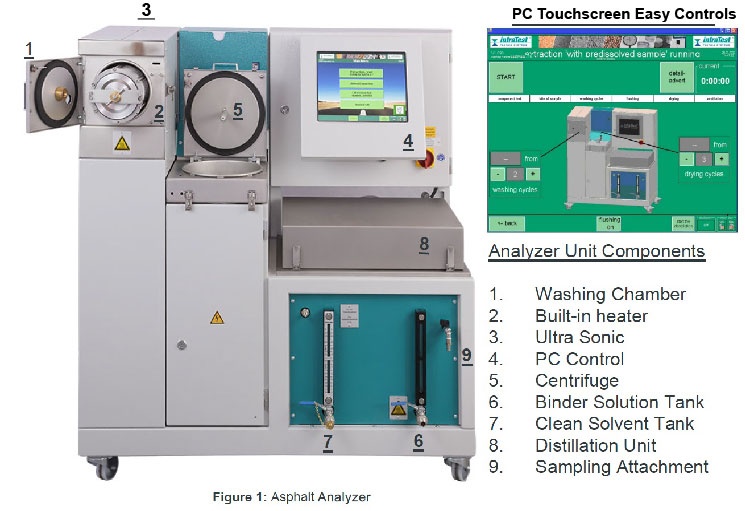Update:
Here is the latest update from Infratest regarding the newly published ASTM D8159-18. ASTM D8159 - 18 Standard Test Method for Automated Extraction of Asphalt Binder from Asphalt Mixtures is approved and available for use. This new test method approved July 2018, covers the quantitative determination of asphalt binder content in asphalt mixtures and pavement specimens, using the automated computer controller or human-machine interface system (HMI), to perform a solvent extraction for specification acceptance, service evaluation, quality control, and research.
LASTRADA Partners has been working with several laboratories that have used this piece of impressive equipment alongside LASTRADA™ software. The construction materials testing laboratories using the InfraTest Asphalt Analyzer have all spoken highly of the device. They report the Infratest Asphalt Analyzer allows for a quick turnaround asphalt extraction test results while maintaining zero-solvent emissions. We have invited Infratest to provide information about their device to our customers and contacts.
Safely Manage Chlorinated Solvents in the Asphalt Laboratory
DOTs and construction materials laboratories across the country are embracing a safer, more productive and accurate way to perform solvent extractions. The InfraTest Asphalt AnalyzerTM provides an automated and enclosed method of performing solvent extractions to verify asphalt content on bituminous mixture, and rubber-modified bituminous mixtures.
Since 1997, the infraTest’s Asphalt Analyzer has been extensively used throughout Europe for the extraction and determination of binder content, including rubber-modified bituminous mixtures, using non-flammable solvents like trichloroethylene. This is the only allowed extraction method in most of Europe due to very rigorous chlorinated solvent use restrictions.
InfraTest’s new ground tire rubber model, Rubber Analyzer, is equipped with a second solvent circuit allowing for the extraction of rubber particles in modified asphalt mixtures. For the first time, contractors, DOTs and researchers are able to accurately quantify the amount of rubber within the mix.
How Does The Asphalt Analyzer Laboratory Test Machine Work?
Running the machine and extraction process is simple and requires limited training; the end-user fills up the provided washing drum with an asphalt sample up of up to 3500g, inserts the sample into washing chamber of the machine, then inserts an empty centrifuge cup into the built-in centrifuge compartment to collect the fines. All the chambers are locked before beginning the extraction procedure, via the built-in PC, the number of washing and dry cycles is selected depending on sample type and size. During the extraction process, binder is collected in the binder recovery chamber and solvent is distilled and recycled with only 25ml permanent loss per extraction. Aggregates are washed within the washing chamber, binder and minus #200 fines are automatically separated, and all minerals are dried. After several uses, refilling the unit with new solvent is done through a closed quick-connect system using a manual foot pump or vacuum pump option further limiting interaction with harmful chlorinated solvents.
How Accurate Are InfraTest Asphalt Analyzer Asphalt Content Test Results?
A recently published Wisconsin Highway Research Program (WHRP)1 study on asphalt extraction methods found that the automated solvent extraction method using infraTest Asphalt Analyzer “has the lowest standard deviations, of all of the test procedures evaluated, for tests conducted within a lab and between labs”. Other test procedures evaluated included ignition oven, centrifuge and reflux methods.
Iowa DOT also evaluated the performance of the Asphalt Analyzer against other extraction methods. The report published by the Iowa DOT2.
“Evaluation of the infraTest Asphalt Analyzer for Performing Extractions on Recycled Asphalt Materials” acknowledges, “Two advantages of the Asphalt Analyzer were the reduced technician time needed to complete the extraction and the reduced time from the start of the test to obtaining the final test results. The T164 test took from 2.5 to 3 hours per extraction where the technician was constantly adding solvent or transferring solvent to the second centrifuge to filter the fines. Afterwards the aggregate was washed over the #200 sieve and then dried. The Asphalt Analyzer process saved overall about 1.5 hours of staff time per extraction. With the Asphalt Analyzer, the unit was loaded and left to do the cleaning and filtering while the technician was free to perform other tasks. The unit dried the sample and at that point the sample was ready for gradation, absorption, and specific gravity testing. The Asphalt Analyzer procedure allowed for quicker turnaround of test results. Where the modified T164 procedure required a 16-hour pre-soak of the RAP in solvent and a wash and drying after the extraction, the Asphalt Analyzer TM required neither. The repeatability of the Asphalt Analyzer was determined using ASTM E691. The repeatability standard deviation is 0.080%. The precision and bias statement for T164 has a repeatability (single-laboratory) standard deviation of 0.18%.
A Risk Assessment showed that the Asphalt Analyzer scored in the low risk range since the Analyzer reduced the time and volume of solution needed while running the test, providing further exposure risk reduction. It is concluded that the machine can provide superior risk controls, leading to improved health and safety conditions.”
1WHRP: http://wisconsindot.gov/Pages/about-wisdot/research/flex-pave.aspx
2Iowa DOT Report: https://docs.wixstatic.com/ugd/4ec725_c4f4a848c7884fa08e2d947c0e02cba8.pdf
To learn more about the Asphalt Analyzer and the Rubber Analyzer, visit InfraTest USA's website: www.infratestusa.com
Article written by

Managing Director at InfraTest USA








